Final Fantasy XIII-2: How Does It Measure Up?
by Orion_NGC1976, HSM team writer
A driving force behind buying a gaming console has been the Final Fantasy series of games; Final Fantasy X with the PS2 and Final Fantasy XIII with the PS3. Since then, I have played IX through XIII (except the online XI and the sequel X-2).
Even though many criticized XIII, I thoroughly enjoyed playing the game. When I heard that there was going to be a sequel to XIII, I was very excited and watch each of the trailers, as they were released on Square Enix’s website. When demo version was available from PSN, I downloaded it and played it, which familiarized me with the gameplay that was slightly different from its parent version. I waited with great anticipation for its release date and when January 31st finally arrived, I picked up the game at Game Stop on my way home.
One reason I was excited to play FF XIII-2 was that I liked the characters of FF XIII: Lightning, Snow, Fang, Vanille, Hope, and Sazh, From the trailers, I knew that Serah, Lightning’s sister and the person they were trying to save in FF XIII, would be one of the major characters in the game, along with a new character, Noel. The trailers also showed a lot of Lightning, so I was expecting to see more of her in FF XIII-2 in the story and gameplay, switching back-and-forth between the two. Disappointedly, that is not the case.
All of the characters from the previous game make at least a cameo appearance in this game. Some characters are only seen briefly and have very little to do with the story. Of course those who were a part of of Serah’s life before she became crystal have a more expanded role. Lightning, who is now in Valhalla, and Snow, who has set out to look for Lightning, fight along side Serah and Noel in one area. Out of the remaining characters, it is only Hope, now matured and a scientist, who plays a role in the storyline of FF XIII-2. There is also some interaction with the members of team NORA, who were briefly in FF XIII.
There is one more new member of the party and that is Mog. For those of you who are familiar with the series, you will recognize Mog as a moogle. The return of moogles to the Final Fantasy series was done in a very smart way, by incorporating Mog as part of the gameplay. Mog communicates important information to Serah and Noel. Mog is also instrumental in finding all the treasure chests. Some chests are hidden and Mog has an ability to make them visible. Other chests are out of reach and Serah or Noel can throw Mog at the chest to open it. Mog is a gift from Lightning and also transforms into Serah’s weapon when a battle begins. Since Mog is also a weapon, planning when to throw Mog may come into play when there are enemies around.
This sequel picks up where FF XIII left off, with the gang saving Cocoon, Fang and Vanille crystalized in the pillar that holds up Cocoon and Serah returns from being being crystalized. Something is different that only Serah realizes; time has been altered. Lightning is gone, but Serah remembers greeting her sister when she returned from a crystalized state. That timeline has been altered and meeting Lightning never happened to everyone else.
FF XIII-2 is about correcting the timeline and changing the past and the future. The new character in the game, Noel, travels back in time to Serah and starts her on their journey together to find her sister and change the timeline along the way.
The story isn’t as elaborate as FF XIII in fleshing out the characters. The character development is focused mainly on the past of the three new characters – Noel, Yeul and Caius – instead of further developing Serah and the other characters that were in FF XIII.
With each release in this popular series, Square Enix has made changes to the gameplay; some well received and others that were received with much criticism. On the whole, I have been very pleased with the progression of the Final Fantasy series with the most recent installments.
Final Fantasy has been historically a turn-based RPG (even with the Active Time Battle System). FF X represented the turn queue visually so you could plan your party member’s actions accordingly. This started to change with Final Fantasy XI and XII, which introduced a more realtime battle structure with auto-actions for the other party members.
This meant that you could only control the party leader and the other characters in the party were controlled by the artificial intelligence (AI) in the game engine. The way you would dictated what the other party members did was through rules, called Gambits, in FF XII and character classes (controlled through paradigms) in FF XIII. I welcomed these changes, because the action of the game was sped up to an almost real-time battle, and at the same time not sacrificing control of when the other characters would heal or go all out in an assault.
In FF XIII the character classifications are Commando (Combat weapons), Ravenger (Combat Magic), Synergist (Buff Magic), Sabatour (De-buff Magic), and Medic (Healing Magic). A set of party members who are of a certain classifications is called a Paradigm. Paradigms dictate the mix of classifications that the party will have at one time. For example, you may set your paradigm to Commando, Ravenger, Medic for the three party members respectively to have a healer in a boss fight and if you wanted to go all out and attack in full force, you may switch to Commando, Ravenger, and Commando. The limitation here was that the characters could only perform the actions that their classification dictated. This is where control over switching paradigms plays an important role to properly control your other members of the party.
FF XII allowed for even more control over your characters by setting up rules that could be quite complex and allowed the character to perform any number of actions that could span across multiple classifications. These rules could also be prioritized, such as healing or remove negative status effects before attacking.
In FF XIII – as with its sequel – the characters’ actions were restricted by their current set classification. Also, there is no way to dictate or predict which action is to be performed before another, i.e. whether to raise a fallen team member or heal another team member first, unless you make that character the leader of the party and select that action yourself. With the FF XII’s Gambits, the player could control which action would happen first, but in FF XIII the player is left to the mercy of the game’s AI. Even though this is inferior to the Gambits, it is definitely superior to going back to turn-based gameplay.
FF XIII-2 continued the same paradigm concept with one twist; the third party member was a monster, which were acquired throughout the game. These monster characters are greatly limited in how far their attributes and abilities could be enhanced; each monster having their own unique limitations. However, you are not allowed to set a monster as the leader of the party; they are completely controlled by the game AI.
This means that your third member would probably be the weakest, and this could present a problem when going up against a strong opponent. This creates another type of strategy. If you level up one monster to its maximum, the only way to move farther with that class of a monster is to find another monster that can be leveled up further. The monsters have only one assigned classification, so in order to change the monster character’s classification, you have to switch out the monster with another of the desired classification.
One step backwards in FF XIII-2 is the reintroduction of random encounters. Random encounters are battles with enemies without any warning, spawning at random times around your party.
In FF XII and XIII you are able to see the enemy visually around you and are indicated on the map. You can make the decision to engage the enemy or to go around them. Of course, if the enemy spots you, they will give chase and a battle could begin, or you could outrun them. This way you can choose to avoid enemies and especially enemies you are not ready to battle yet.
FF XIII-2 has brought back random encounters, but with the addition of the possibility of fleeing the encounter or initiating a preemptive attack. This is controlled by a timer that begins when the enemy spawns around you. Before the timer runs out and the battle begins, you can either attack a nearby enemy thus initiating a preemptive attack, but if they attack you first then a normal battle will begin. If you can outrun the enemy, then you can successfully flee the battle. The success of this attempt to flee can be monitored in a couple of ways; you can see where the enemy is in relation to you on the map and there is a colored ring that is around you that starts out red, and as you successfully flee from it, will turn to blue. If it stays red when the timer runs out, you failed to successfully flee and a normal battle will begin.
This method makes preemptive attacks too easy. In FF XIII, you had to sneak up on an enemy and blindside them from the back or side to successfully execute a preemptive attack. Even attacking from behind did not guarantee a preemptive attack as some enemies have better senses then other and you may be detected. This puts executing preemptive attacks as part of the gameplay. How it is implemented in FF XIII-2 has removed it from the gameplay.
When leveling up characters, random encounters are great and speed up the process, but when trying to explore an area and get all the hidden items, they can be really annoying. This is certainly the case with FF XIII-2. The random encounters with the timer made FF XIII-2 less enjoyable to play than FF XIII.
In both Final Fantasy XIII games, characters are leveled up by spending Crysterium points for attributes. There is a difference that gives an advantage to FF XIII-2 to make gameplay much easier. With FF XIII-2, there are no storyline limitations to maxing out the abilities of Serah and Noel. In FF XIII, the Crysterium was only expanded at certain points in the story, therefore limiting how far you could level up before a storyline boss fight. With FF XIII-2, it is very easy to over-level your characters to you give you a big advantage in boss fights.
One criticism of FF XIII was how linear the gameplay was and was sometimes referred to as “one big endless tunnel.” FF XIII-2 returns to a more free travel gameplay, where you can travel to different time periods freely, but only ones that have been unlocked, of course.
Some side quests require you to travel to different time periods. Although it appears that it is an open game to roam as you may, it is linear in its own way. Time periods are unlocked as the game progresses and once you have done all the side quests in that time period, there really is no reason to go back to that area.
At the time of writing this, I am at the very end of the game, right before the final boss fight. There are time periods that have not been unlocked yet, so I am hoping that there will post-game play in these areas unlocked areas. I have not looked at walkthroughs or cheats, so I do not know what lies beyond the end of the game. I have however heard from my son that there are nine different endings.
The one stable constant in the Final Fantasy franchise is the ridable chocobos, and FF XIII-2 is no exception. There are some quests that cannot be completed with out getting on a chocobo. There is also a gambling area in the game where you can play slot and race your chocobo. Another staple of the series is fantastic music and Final Fantasy XIII-2 doesn’t disappoint in that regard also.
Overall, I did enjoy playing the game and learning about Noel’s past. Final Fantasy XIII-2 is a “lite” version of Final Fantasy XIII and if you keep this in mind then Final Fantasy XIII-2 will be an enjoyable addition to your collection.


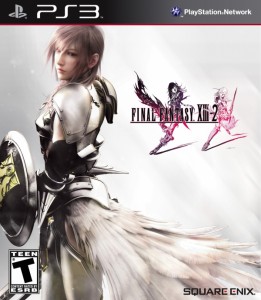
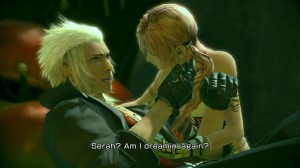
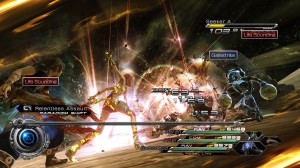
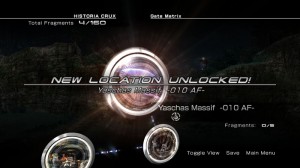
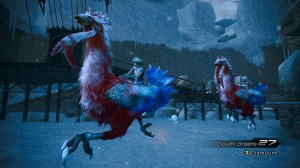
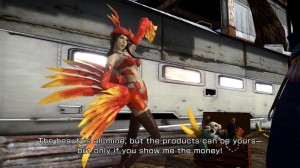
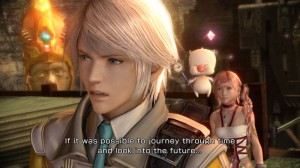



I played the demo for this game as well and though I was looking forward to purchasing it since I heard about it, I decided to wait a bit as I wasn’t completely impressed by it. I liked FF 13 but I wasn’t as impressed by it either, except for the graphics in each of them which are outstanding. The linear play in these games has become kind of a turn off for me, especially now that I have become immersed in the non-linear world of Skyrim. We can only hope that the next FF release is a non linear world we can explore freely.
Thanks for the review Orion, it has helped me decide whether I want this title or not. Good job describing all of it.
I really enjoyed the game. I not a big fan of the ending, but the rest of game made up for it. After finishing up the main story line you can dive in to a ton of extras. I got the DLC Lighting pack. After beating her (Very challenging) you’ve got her in your party. I hear that alot more DLC is planned so this could be a very long adventure.